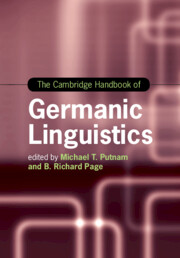Book contents
- The Cambridge Handbook of Germanic Linguistics
- Cambridge Handbooks in Language and Linguistics
- The Cambridge Handbook of Germanic Linguistics
- Copyright page
- Contents
- Figures
- Maps
- Tables
- Contributors
- Acknowledgments
- Germanic Languages
- Part I Phonology
- Part II Morphology and Agreement Systems
- Part III Syntax
- Part IV Semantics and Pragmatics
- Part V Language Contact and Nonstandard Varieties
- Chapter 29 Second Language Acquisition of Germanic Languages
- Chapter 30 Urban Speech Styles of Germanic Languages
- Chapter 31 The West Germanic Dialect Continuum
- Chapter 32 The North Germanic Dialect Continuum
- Chapter 33 Heritage Germanic Languages in North America
- Chapter 34 Minority Germanic Languages
- Chapter 35 Germanic Contact Languages
- Index
- References
Chapter 31 - The West Germanic Dialect Continuum
from Part V - Language Contact and Nonstandard Varieties
Published online by Cambridge University Press: 31 March 2020
- The Cambridge Handbook of Germanic Linguistics
- Cambridge Handbooks in Language and Linguistics
- The Cambridge Handbook of Germanic Linguistics
- Copyright page
- Contents
- Figures
- Maps
- Tables
- Contributors
- Acknowledgments
- Germanic Languages
- Part I Phonology
- Part II Morphology and Agreement Systems
- Part III Syntax
- Part IV Semantics and Pragmatics
- Part V Language Contact and Nonstandard Varieties
- Chapter 29 Second Language Acquisition of Germanic Languages
- Chapter 30 Urban Speech Styles of Germanic Languages
- Chapter 31 The West Germanic Dialect Continuum
- Chapter 32 The North Germanic Dialect Continuum
- Chapter 33 Heritage Germanic Languages in North America
- Chapter 34 Minority Germanic Languages
- Chapter 35 Germanic Contact Languages
- Index
- References
Summary
The continental West Germanic dialect continuum roughly encompasses the territory of modern-day Germany, Austria, the German-speaking part of Switzerland, the Netherlands, the northern half of Belgium (Flanders), Liechtenstein, Luxembourg and South Tyrol, in northern Italy. The dialectal varieties in this region differ and are classified on the basis of phonological, morphological, and lexical distinctions. The varieties of Netherlandish and Frisian represent the northernmost part of the continuum. The remaining area, in which Standard German can be viewed as the high variety, is traditionally divided into subdialects utilizing consonantal and vocalic innovations, e.g., the High German consonant shift. The German dialects also differ in terms of noun case distinctions, plural verb morphology, and lexical variation.
Keywords
- Type
- Chapter
- Information
- The Cambridge Handbook of Germanic Linguistics , pp. 736 - 760Publisher: Cambridge University PressPrint publication year: 2020



